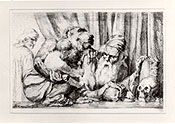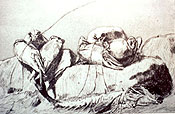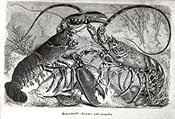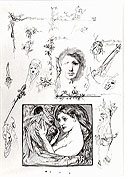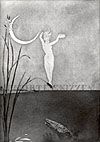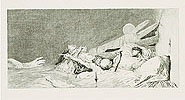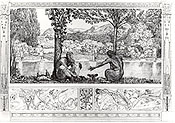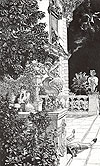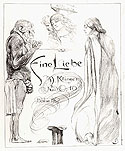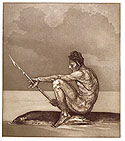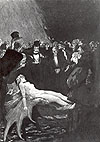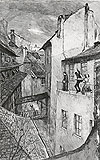The browser will either open the file, download it, or display a dialog.
|
|
"Impulses and Desires": Klinger's Darwinism in Nature and Society |
|||||
|
It has long been recognized that the graphic art of Max Klinger probes the mysteries of human behavior and psychology, particularly those effected by biological drives. Yet surprisingly scant attention has been paid to Klinger's response to Charles Darwin, whose theories revolutionized conceptions of human nature. Darwin's studies were so far-reaching in their implications that even the most traditional themes of literature and art dealing with relationships and emotions—romance, beauty, courage, aggression, death—became encoded with new meanings. The impact of Darwin was not confined to the natural sciences but also, through his breadth of references in The Descent of Man, to the fields of anthropology, sociology, and psychology. Civilized man was kin to animals as well as "barbarians" whose habits, customs and mythologies were under scrutiny by ethnographers seeking to uncover traces of ancestral links.1 At the same time, German archaeologists like Heinrich Schliemann began turning their attention to pre-classical cultures in the Middle East and in Europe.2 Conversely, contemporary society was being examined through a Darwinian lens for signs of atavistic brutish behavior. | |||||
| The presence of a Darwinian worldview in Klinger's art must be sought in this larger comprehensive sense, evidenced not only through his many references to natural history, but in his scenes of social criticism and his exploration of myth and dreams as vestiges of the primitive self. Darwinian influence is especially compelling when applied to Klinger because it provides an ideology encompassing the artist's disparate themes and his temporal sweeps through history. Like the writings of most German Darwinists, his work began with studies of nature and developed into studies of contemporary society. Issues were presented from different historical moments, tracing Darwin's "unchanging laws" (primarily sexual selection) through the mythologies of Genesis and in ancient Greece. In a post-Darwinian world, as the Swedish art critic Oscar Levertin wrote, "the tie between primeval times and the present day was knit more strongly than ever and all of the most ancient myths and fantasies took on a deeper meaning."3 | ||||||
| Klinger had read Darwin by 1875 when he completed the drawing Darwinian Theory (fig. 1) and wrote to his parents in October from art school, requesting the exchange of their Darwin material.4 The collected works of Darwin, with over two hundred illustrations and a photograph of the author, had been published in Germany the previous year to great acclaim.5 Klinger's interest in Darwin, at the impressionable age of eighteen, occurred at the onset of his most fertile years of creative activity and preceded his knowledge of Arthur Schopenhauer, for which it provided a foundation. Since Schopenhauer, who was inspired by Georges Cuvier, Jean-Baptiste Larmarck, and Thomas Hobbes, anticipated many of Darwin's theories and is quoted in The Descent of Man, the philosopher served to reinforce Klinger's Darwinian perspective. The artist's subsequent engagement with Emile Zola and Friedrich Nietzsche provided a similar function, as did his friendship with the Taine-influenced Danish critic Georg Brandes during the late 1870s in Berlin. | ||||||
| Klinger would have received an extensive education in science and anthropology through reading Darwin's books that were crammed with citations from other publications. Indeed, Darwin's encyclopedic references provided a discursive narrative of the historical development of evolutionary thought with sources culled from contributors in the arts, such as the romantic poet Jean-Paul Richter whom Klinger admired, as well as the sciences. In Germany information on evolutionary theory was inescapable thanks to the burgeoning literature by Darwinist popularizers—Ludwig Büchner, Carl Vogt, Carus Sterne, and Ernst Haeckel, among many others—available as books or articles in a variety of magazines that devoted considerable space to keeping the public abreast of scientific advances. Klinger's favorite newspaper, the Leipzig Illustrirte Zeitung, was a treasure-trove of information, publishing scholarly reviews of scientific books (a four-part feature on Haeckel's Anthropogenie appeared in the1875 January and February issues) as well as general reporting on zoos, aquariums, and natural history museums. The comprehensive scope of the newspaper, which included international coverage of cultural events, science, politics, military exploits, and travel, resulted in illustrations whose collage-like juxtapositions located European high society in a global Darwinian context of geographic and ethnic diversity. | ||||||
|
|
||||||
| Evolutionary theory was embraced in Germany more readily than in other countries, prompting Darwin to remark in 1861 that "the support which I receive in Germany is my chief ground for hoping that our views will ultimately prevail."6 Germans were, to a certain extent, more prepared for the notion that "man is not above nature, but in nature" because similar ideas had been anticipated by revered authors like Goethe. His belief in transformation, descent theory, and evolution were contained in "The Metamorphosis of Plants" and Faust, Part II, which Klinger later read.7 Romantic Naturphilosophie, despite its spiritual idealism, also espoused the interrelationship of man and nature, and a concept of the organic world based on process and historical change. By mid-century, scientists Vogt, Büchner, Jacob Moleschott and Friedrich Albert Lange examined issues in philosophy, history and anthropology from a materialist orientation, and under the influence of Ludwig Feuerbach and David Friedrich Strauss, rejected a faith in divine creation and a teleological worldview. They not only enthusiastically accepted Darwin, albeit with certain qualifications, and popularized his theories during the 1860s, but even "scooped" him by inferring man's kinship with apes in advance of the 1871 The Descent of Man.8 | ||||||
| These scientific materialists were also political activists who applied the paradigm of evolution to the cause of social reform. The first generation of German Darwinists adopted left-leaning political positions which ranged from the "bourgeois socialism" of Büchner and Lange to the Marxist ideology of August Bebel and Friedrich Engels. Opposition to church and state was an early hallmark of the movement, initiated by Haeckel's famous 1863 Stettin speech, in which he declared that "neither the weapons of tyrants nor the curses of priests" could suppress the truths of evolutionary theory.9 Socialist Darwinists (in distinction to capitalist Social Darwinists who championed the "survival of the fittest" justification of power and wealth) confidently predicted an ascent to a future society of greater equality predicated on evolving human reason and compassion.10 The socialists' adoption of Darwinism did not go unopposed, especially by more politically conservative German biologists who, led by Rudolf Virchow, lent support to Bismarck in the enactment of his anti-socialist laws of 1878. Within these controversies of science and politics, Klinger and his associates in Berlin projected an anti-establishment attitude during the late 1870s when they were characterized by their friend Georg Brandes as "nihilists, socialists, atheists, materialists, naturalists and egoists…[who] honored the politics of the Paris Commune."11 | ||||||
| Darwinian Theory reveals a full grasp of issues swirling around Darwinism in Germany. The drawing depicts, on the right, a natural scientist, presumably Darwin, with a book and two skulls, simian and human, referencing proofs through comparative skeletal anatomy of man's ancestry. Fossil remains of a primitive homo sapiens closer to the catarhine ape had been discovered in 1865 in the Neander Valley near Düsseldorf. While these objects symbolize the materialist "new faith" described by David Strauss, the "old faith" of revealed religion is represented by the departing angry priest, already fading to a ghostly memory. During the 1870s anti-clericalism permeated German politics. An alliance between Bismarck and the liberal parties had resulted in a ban on monastic orders in Prussia, with many priests imprisoned or exiled. Dominating the tableau is a smiling ape, identified as a Cynothecus niger, whose hand rests familiarly on Darwin's shoulder while the other cradles an infant playing with a rattle.12 The intimacy of child and ape reveals man's origins, which Darwin appears to be contemplating, while also referencing Ernst Haeckel's famed Biogenetic Law asserting that "ontogeny recapitulates phylogeny"— that "the history of the fetus is a recapitulation of the human race."13 By this way of thinking, the baby is closer to his simian past than a mature adult. Annegret Friedrich has suggested that the two groups are gendered representations of the male domain of scientific reason versus the female realm of nature and nurture.14 Her interpretation transforms this drawing into an important signpost for Klinger's future concerns, and is reinforced through comments by Darwin and Haeckel attesting to the intense maternal affection observed in monkeys. Haeckel maintained that human behavior derived from "the instinct which is found in its extreme form in the exaggerated tenderness of the mother-ape."15 | ||||||
|
|
||||||
| Klinger's graphic art from the mid-1870s through the mid-1880s is replete with images documenting Darwin's theory of the struggle for existence and the struggle for mates. His juvenilia reflect an early—and typically male adolescent—focus on soldiers and battles, as well as bugs and lizards. Klinger's mother later recalled his absorption with his "friends" (the "butterflies and beetles") in the family garden.16 His interest in nature would have been later extended by Realschule classes in natural science.17 Klinger's sketchbook from 1874–77, completed while at art school in Karlsruhe and Berlin, contains frequent scenes of violence and sexuality, many of which would provide sources for his later prints. Darwinian evidence of the harsh lessons of survival, dominance, and death abound, as in the monstrous Goyaesque Fox Hunt, with animals pursued by brutes, or Buzzards with a Dead Hare, documenting an incident observed in the backyard of his parent's Leipzig home.18 The dark side of nature's food chain is grimly depicted in Siesta I, (fig. 2) from his first published graphic series Etched Sketches (1879), where two lobsters enjoy an after-dinner snooze next to the carcass of a fish they have consumed. Compositionally similar to the frontal "display" format of scientific illustrations, the image recalls a scene of crustacean combat, Common and Spiny Lobsters (fig. 3), in Alfred Brehm's widely read multi-volume Illustrirtes Tierleben (1864–69). | ||||||
| Many of Klinger's animal drawings may also have been sketched at the Berlin zoo and aquarium. Brehm, a student of Haeckel, was the founder and director of the Berlin Aquarium, which opened in 1869. It contained not only fish and reptiles, but also an aviary and the city's largest collection of monkeys and anthropomorphous apes.19 Drawings for Brehm's books were based in part on studies made there and at the Berlin zoo, which had undergone extensive expansions during the early 1870s. The zoo—a central attraction of Berlin social life that included restaurants, band shell and skating rink—had been visited by Klinger shortly after his arrival in the city.20 It featured new buildings in exotic architectural styles (an Indian Elephant Pagoda and Islamic Antelope House) and, beginning in 1878, served as the venue for ethnographic performances by non-Western tribal natives, ranging from Inuits to "Nubians" from Sudan. These shows, which were extremely popular, ensured a profit for the zoo and source material for anthropologists, while offering a Darwinian tableau of nature, primates and primitives.21 Klinger's drawings from this period also feature individuals of diverse ethnicities frequently paired with predators, as in Tiger Attacking a Chinese Man, The Lion Tamer and Moor with Tiger.22 His work reflects not only the experience of being an armchair traveler through reading Darwinian literature, but also an awareness that most scientists considered non-Caucasians less advanced on an evolutionary scale and on closer terms with their animal progenitors and prehistoric man. | ||||||
|
The circumstances of life for mankind's ancestors are explored in four prints within Klinger's cycle Intermezzos, 1881, in which deadly battles occur between members of one's own species, more advanced species, and a hostile environment. Pursued Centaur illustrates an evolutionary saga of adaptation, survival, and extinction. (fig. 4) The escape of the centaur appears doomed in the face of superior opposition by the more highly evolved men riding horses. Their helmets and village home in the background indicate their increased level of civilization. Klinger's image also references the natural male attributes of "greater size and strength" (in comparison to females), "more developed muscles…[and] greater courage and pugnacity. . .all due in chief part to inheritance from his half-human male ancestors."23 In Battling Centaurs the setting shifts to an icy mountain range, with two figures locked in mortal combat over the prize of a dead rabbit. The series concludes with tranquil domestic scenes of everyday life in Moonlit Night and Landslide, which allude to the importance of procreation, inheritance, and community once the "struggle for existence" has been accomplished. | |||||
|
Klinger suggests that any such serenity is an illusion, however, given the realities of human and animal behavior (the boy centaur hurling a rock at a snake in the foreground of Landslide) and the aimless indifference of nature (the impending landslide). These representations recall Nietzsche's revisionist view of the Greeks, expressed in The Birth of Tragedy, 1872, as more barbaric and aggressive.24 They also echo the uncompromising vision of Haeckel, who noted that "might goes before right as long as organic life exists" and squelched any innocent belief in a benign or moral nature:
Klinger's art frequently underscores this viewpoint. Little distinction exists between the centaurs fighting over a hare and the crazed men fighting in Rivals (from the cycle A Life, 1882) whose conquest will be the prostitute observing them with a satisfied smile. The image is nearly a caricature of Darwin's animals "engaged in desperate conflicts…in the law of battle for the possession of the female" and a reminder that "all civilized nations are the descendents of barbarians."26 Indeed, the existence of semi-human hybrids was believed by many to be a fact verified by scientific research. Carus Sterne cited medical reports by Greek military physicians recording army recruits with partially formed foot-hoofs and vestiges of tails. Illustrations for his book Evolving and Vanishing, 1876, included photographs of a Greek faun statue and a contemporary Indian boy from Calcutta who was born with a tail.27 While Klinger lived in Berlin, he could also have visited "freak shows," endorsed and sometimes facilitated by anthropologists, where people with deformities such as tails, excessive body hair growth, or small skulls (microcephalics) were promoted as atavisms evidencing Darwin's "missing link."28 |
||||||
| Rivals testifies to Klinger's awareness that Darwin attached tremendous significance to the role played by sexual selection in evolution. Darwin considered it to have been the most efficient factor separating man from animals, and responsible for the primary human racial and gender differences, both physical and mental. This process had benefited the male. His greater ardor and energy in pursuit of the more submissive and "less eager" female earned him, according to Darwin, superior strength and size, as well as "the higher mental faculties [of]. . . genius. . . perseverance. . .imagination and reason."29 Females, who at least within the animal kingdom exercised the power of choice in a mate, were stripped of even this level of assertiveness in human society, resulting in a proportionately diminished brain size. | ||||||
|
Klinger also believed in the centrality of sexuality in human affairs—devoting his art principally to an examination of the nature and consequences of desire—but he diverged from Darwin in his conviction that women and men were equally possessed by and suffered from their carnal drives. The drawing of a woman embracing a lion is one of many images by Klinger that pairs felines and females in order to portray awakening and mature sexuality. (fig. 5) The trance-like absorption (and gaze of self-recognition) of the woman, echoed in the face above, is in contrast to the pious veiled figures with closed eyes, and visualizes a state of possession by forces whose biological origins are embodied in the decorative doodles of plants, monkey-hybrid, and giraffe.29 Klinger's animals are not mere avatars of female appetites, however, but seem to function as sentient male partners. His couplings of beauties and beasts are given greater plausibility through Darwin's assertion that "higher animals possess memory, attention…and even more imagination and reason."30 Klinger's depictions of women as thoughtful sexual beings would seem to free him from accusations of prudish Victorian gender bias. Yet, while he is not guilty of presenting "eagerly promiscuous males pursuing females, who peer from behind languidly drooping eyelids," as Ruth Hubbard has characterized Darwin's world, nonetheless his scenes of deviant passions do embody another kind of "wish fulfillment dream of a proper Victorian gentleman," who, like Darwin, associated female intuition and perception with "a lower and past state of civilization."31 Klinger did not, however, exempt himself from that condition since his male protagonists—subject to the same torments of love—are frequently self-portraits. | |||||
|
Themes of incipient danger, sexuality, and lability are announced in the Title Page (fig. 6) of Klinger's cycle, Etched Sketches,1879, and repeated throughout his early work, as in Bear and Elf (from Intermezzos, 1881). In both prints, split-second moments are captured as slender, nearly weightless girls hover on fragile reeds or tree branches. The precariousness itself seems to thematize Darwinian theory in which, as Gillian Beer has noted, there is "no place for stasis…or constant equilibrium. Nor…does it allow either interruption or conclusion."32 Like actors in a Darwinian play, the nymphs "coyly" tease the lumbering clumsy beasts, who are forever subject to gravitational realities.33 The biological underpinnings of this courtship are implicit in the aquatic and nocturnal environment. Oceans and watery sites are ubiquitous in Klinger's art, setting the stage for moments of passion and transgression. In the wake of Darwin, the sea gained new prominence, having replaced the mythic garden as the location of origination and primeval procreation. Darwin observed that "all…mammals originally descended from some amphibian-like creature, and this again from some fish-like animal."34 Man's ancestry was now traceable to not only the ape but, according to Nietzsche "living slime," or, as John Ruskin observed with disgust, "the filthy heraldries…[of] the ascidian [sea squirt] and the crocodile."35 Klinger's nymph is literally kin to her pursuer, as embryonic research confirmed, and her ability to escape, metaphorically speaking, illusory. As Darwin cautioned, "man with all his noble qualities…still bears in his bodily frame the indelible stamp of his lowly origins."36 Even imagination, a quality which this ethereal nymph has frequently been seen to symbolize, had been furthered by sexual selection, according to evolutionary theory. Those who read Darwin were additionally aware that the moon referenced not only the Romantic night world of fantasy, but, in combination with water, other internal atavistic evidence. Darwin noted that "in the lunar or weekly recurrent period of some of our functions [such as menses] we apparently still retain traces of our primordial birthplace, a shore washed by the tides."37 | |||||
|
For Klinger, man could revisit his ancient past in dreams, which, like the unknown watery depths, were the gateway to the unconscious and the release of carnal desire. In Fears, from the series A Glove, 1881, the protagonist/artist appears in the grip of a terrifying nightmare whose erotic nature is signaled by the shape of the glove (the symbol of the woman he desires), the water, moon, and reptile. (fig. 7) The association of dreams and fetishes with primitive sensibilities was informed by recent anthropological research. Lubbock (quoted by Darwin) considered dreams integral to the formation of early religion, remarking that "to the savage they have a reality and an importance which we can scarcely appreciate," while Bastian identified beliefs in fetishes as characteristic of the lowest stage (the most sensual and emotive) of human mental development.38 Nietzsche asserted that the dream "takes us back again to the remote stages of human culture and provides us with a means of understanding them better."39 In dreams, claimed Nietzsche, we re-experience the thought processes of our less-evolved predecessors, which are typified by a confusing absence of logic, reduction of memory, and a heightened visual clarity suggestive of the hallucinations prevalent among ancient peoples. Two decades later Freud would assert that "dream-work" (whose symbols are almost always sexual) facilitates our return not only to childhood, but to "the archaic prehistory" of the "entire human race."40 Klinger, like Schopenhauer, believed that it is ultimately carnal needs which betray human ancestry to creatures whose lives were determined by instinct rather than intellect. |
|||||
|
Klinger referenced primal drives not just through dream experiences, but through creatures of the "lower orders" who were extinct, aquatic, or reptilian. Lobsters, for example, frequently personify lust, as in the drawing Nightmare, 1878, where a febrile young woman is raped by one.41 Crustaceans were recognized by Darwin as being the first class to possess secondary sexual characteristics; flying reptiles and dinosaurs played central roles in the evolutionary drama, representing transitional hybrid forms which ultimately linked man to his progenitors: "even the wide interval between birds and reptiles has been shown…to be partially bridged over…by one of the dinosaurians.42 One of the two monstrous heads in Fears emerges in Abduction (fig. 8), also from A Glove, as a long-tailed Pterosaur, known to Europeans through recent paleontological discoveries in 1859 from the Bavarian Jurassic limestone quarries. These also yielded the fossil remains of an Archaeopteryx (a small prehistoric bird) in 1861 and 1877, which were discussed by Darwin.43 Skeletons of dinosaurs, as well as other reptiles and vertebrates, were displayed in the Berlin Museum for Natural History when it opened in 1889. Previously, the collection had been housed in university buildings.44 Klinger's familiarity with dinosaurs is confirmed by an early untitled sketch that provocatively juxtaposes a dinosaur, lion head, human faces, and a beached fish supporting a prostrate boy.45 | |||||
|
Myth construction, as well as dreaming, was regarded as symptomatic of "the human intellect in its early childlike state," and Nietzsche observed that primitives composed mythologies with the same "confusion and capriciousness" that marked their dreams.46 Myths were frequently invoked by scientists as intuitive anticipations of evolutionary truths. Among these, few were as prescient as Ovid's Metamorphosis. Aldous Huxley began his essay "Man's Place in Nature," with an acknowledgement that "Ovid foreshadowed the discoveries of the geologist," noting that "though the quaint forms of Centaurs and Satyrs have an existence only in the realms of Art, creatures approaching man more nearly than they in essential structure…are now not only known, but notorious."47 Klinger's decision to base a series of etchings on three Ovidian tales—"Pyramus and Thisbe," "Narcissus and Echo," and "Apollo and Daphne"—is therefore consistent with his Darwinian orientation. In this cycle, Rescues of Ovid's Victims, 1879, Klinger rewrites the stories (as Ovid had re-told the Greek myths) as mordant romances. In Narcissus and Echo I (fig. 9) the protagonists are allowed to embrace and kiss under the watchful eye of a faun and centaur, framed by blossoming vines and Cupid's arrow. Klinger's visualization of the text underscores the sexual nature of Nietzsche's Dionysian Greeks not only through the action and characters, but also the lush setting. Indeed, evolutionary themes of fertility, growth, reproduction, and transformation pulsate throughout his art, evidenced by hybrid figures and arabesques. Klinger's factual transcriptions of a fecund nature echo the style and imagery of Darwinian narratives, inviting comparisons with passages that evoke the busy richness of nature. | |||||
|
|
||||||
|
The same obsessive detail describing a nearly claustrophobic profusion of organic life characterizes many of Klinger's contemporary scenes of passion, such as In Flagranti from the cycle Dramas, 1883, (fig. 10) as he traces the constancy of biological drives through time. Living in a zeitgeist of scientific materialism, Klinger was well aware of the reductionist definition of romance as, in the words of Haeckel, essentially "copulation or fertilization." The "myth" of Adam and Eve and "famous fictions" like Paris and Helen were now regarded as "the poetic expression of the immeasurable influence, which love, in connection with ‘sexual selection,' has exerted.48 While Haeckel acknowledged the "misery, vice, and crime" caused by the "devouring flame" of passion, he remained buoyantly optimistic, however, about a future rooted in the truths of nature and the beneficent aegis of natural selection. Klinger, like Schopenhauer and his popularizer Eduard von Hartmann, drew different conclusions. Noting that love affairs often lead to suicide, murder, or insanity, Schopenhauer compared physical attraction to being "under the influence of an impulse akin to the instinct of insects."49 The murderous rage of the cuckolded husband in In Flagranti reveals the thin line that divides civilized man from his animal progenitors, suggesting Klinger's agreement with Carus Sterne's prediction that "the future promises the most difficult struggle of all…against the lower drives and desires, the struggle against oneself."50 Klinger's task as an artist was to probe the ravaging psychological scars of that battle. | |||||
|
His bleak view of eroticism's power of entrapment is revealed in the rejected drawing, 1887, for the title page of the cycle A Love. (fig. 11) Engulfed in despair, the bespectacled aging ape-man and robed woman emblematize, respectively, carnal drives confronting virtue and denial—the conflicting forces torturing Klinger and his lover bound to the pillar. With hands folded in devotional attitudes as if before an altar of love whose sacred relics include the cat, top hat, and folded glove, the figures invoke our pity as victims of forces beyond their control which will only cause anguish. The pot-bellied old ape-man suggests that the experience is a humbling one.51 | |||||
| Klinger extended his historical survey of sexual attraction to Genesis in the series Eve and the Future, 1880, reconsidering the Judaic-Christian "myth" of creation in light of Darwin's information.52 Both accounts have striking parallels, incorporating elements of nature, desire, death, and loss of innocence. Klinger's first drawings on this theme were made in 1875, the year in which he had discovered Darwin. The cycle is composed of three pairs of prints, each including a scene from the Biblical story with a symbolic image of the future. As the series unfolds Eve (in Eve) sits in paradise, significantly positioned in proximity to a body of water. She appears lost in a daydream while absently stroking her long hair. According to Klinger, the temptation has already occurred to her as a "thought."53 First Future depicts a narrow passageway between high boulders at the end of which looms a seated tiger. The vision offers a shocking contrast to Eve, establishing the carnal and dangerous nature of her musings and the bleakness of a future in which there is no way back to paradise or, thanks to Darwin, forward to an afterlife. Klinger described First Future as a "terrifying creature in front of a permanently blocked path (I am a Fatalist)."54 Both Schopenhauer and Nietzsche had previously speculated on the kinship between the human race and "the tiger and the ape."55 | ||||||
|
The temptation itself occurs in The Snake, which depicts Eve gazing with satisfaction into a mirror obligingly held by the snake hanging from a branch of the apple tree. It is clear that the knowledge gained is an awareness of her own desirability; the nearby lake and reptile also imply the discovery of her sexual nature. The snake's anthropomorphic attributes highlight their kinship in a post-Darwinian world where snakes "have some reasoning power, strong passions and mutual affection."56 The focus on beauty and vanity, while traditional, also recalls the role played by female physical appearance as an important factor in sexual selection. Second Future (fig. 12) presents a chilling vision of a predator clutching a razor-sharp spear described by many critics as a "satyr" and by Klinger as "a demon swimming from another world."57 The weapon's phallic reference suggests the dual nature of primal pursuit, for both sustenance and procreation. Second Future can be compared to a distant transitional stage of human evolution as described by Darwin: "The early progenitors of man must have been once covered with hair…their ears were probably pointed… and their bodies were provided with a tail….at a still earlier stage [they] must have been aquatic in their habits."58 This image touched a nerve, eliciting pejorative remarks from the conservative critic Jonas Rasch in the Aftenposten when it was exhibited in Kristiania, Norway in November 1880. Rasch was horrified by the print, scoffing that even the most "ardent supporters of Darwin" would concede that man's ancestors weren't this monstrous.59 It is not surprising that the series triggered Darwinian associations, since the names "Adam and Eve," like apes and angels, had become code words signifying alternative theories of creation and human nature. References to the debunked first pair appeared in publications by, among others, Haeckel, Vogt, Büchner, and Bebel. | |||||
| With Second Future, Klinger elucidates more clearly the message of the series: that the future recapitulates the past because it is pre-determined by our origins from which there will never be any rescue via evolutionary ascent. Together with all organic matter, we are part of the cycles of growth and decay, no longer graced by immortal salvation. Eve's awareness of her sexuality is an acknowledgment of her links with an animal ancestry. Klinger's pessimist vision echoed the sentiments of Nietzsche, who observed that modern man "thinks with sorrow of his origins and is often shamed. . .he gazes sadly into the future: he knows in advance that his posterity will suffer from the past as he does."60 The series concludes with Adam and Third Future, scenes of expulsion and punishment. Adam strides forth into a barren rocky landscape like a "little Hercules," as Rasch observed, his role of dominance asserted in the post-paradise world. The entwined bodies of Adam and Eve imply their new relationship as lovers and, in an earlier drawing, they were accompanied by Cupid. Assessments of blame, guilt, and reprisal are introduced here against Adam and, in the macabre Third Future, the institution of Christianity. Borrowing a scene from Jean-Paul's novel Hesperus, Klinger represents death as a skeleton vigorously pounding sinners' heads into construction material for paving the streets of hell. Klinger observed that the only certainty about the future is that "there is no future."61 In Third Future, the presence of the cross in the background above the skeleton highlights the duplicity of the church, wielding, as Carl Vogt had concluded earlier, "the fear of punishment," and "the hope of reward in a dreamt-of beyond" to enforce moral standards directed against, among other things, the satisfaction of sexual desires.62 | ||||||
| Within the context of this graphic cycle, the cross is also a reminder that the creation narrative in Genesis is equally a misogynist myth of female guilt, a theme which Klinger explores in the sequels to Eve and the Future set in contemporary Germany: the series A Life. 1884, and A Love, 1887. The first two prints for A Life return to paradise, with Preface I and II depicting Eve and a demonic Adam. The inscription below the image in Preface I quotes from the serpent's deceitful promise to Eve: "Ye shall not surely die, but your eyes shall be opened." In subsequent scenes, Klinger chronicles the story of a young girl who, like Eve, submits to temptation. Deserted by her lover and ostracized by society, she is forced to turn to prostitution and, finally, commits suicide. Klinger's historical saga of injustice, rooted in the Garden of Eden, perpetrated by an androcentric society and church was inspired by the experimental naturalism of Emile Zola, the social criticism of Brandes (who had translated Mill's The Subjection of Women into Danish in 1869), and the work of his close art school friend, the Norwegian painter Christian Krohg, to whom he had dedicated Eve and the Future. Krohg's advocacy of women's rights culminated in his painting and novel Albertine; his criticism of Social Darwinism was the subject of his painting Struggle for Existence,1889, depicting starving children on a snow-covered urban street fighting for bread crumbs.63 | ||||||
|
A Life also parallels the theme of the Darwinian socialist August Bebel's 1879 book Woman in the Past, Present, and Future (originally titled Woman and Socialism), which reviews the history of female oppression.64 Bebel lays the blame especially on the "Christian State," first evidenced in Genesis. He notes that this misogynist spirit, in which Eve is stigmatized as a seductress, "is still active today…the myth of Adam being beguiled by Eve in Paradise still holds its own in our ideas and laws."65 Bebel's central thesis is an indictment of the bourgeois social order, which has deviated from nature in a manner that is discriminating and exploitative. He regards the sexual impulse in Darwinian terms as a "law of nature" for both men and women whose denial, as Freud later maintained, results in debilitating mental and physical conditions. Bebel asserts that the patriarchal church and state condemn and punish women for the extra-marital "gratification of [their] natural impulses," while sanctioning similar male behavior. He cites the high female suicide rate and observes that prostitution instances "the revolting illustration of the subjection of woman to man."66 Klinger also gives a Darwinian spin to his tale, highlighting the collision between biological drives and social strictures. Sexual consummation occurs in Temptation during, predictably, a descent into oceanic depths between embracing lovers astride two giant fish. In Chained (fig. 13) the carnal nature of the woman's transgressions are symbolized by her bondage to a prehistoric bat-like creature. Chained reveals the hypocrisy and condescension of the upper class "gentlemen" who are responsible for her ruin. The image recalls Bebel's unmasking of high society's double standards:
The development of Klinger's Darwinian themes from biology to sociology resulted from his awareness of humanity as participants in a larger universe. In his essay Malerei und Zeichnung, he wrote: "man is not a person confined by his individual form, but a being who exists in relation to and dependence on external forces; he is above all a representative of his species."68 Klinger's shift to studies of behavior in contemporary society paralleled the direction taken by many German Darwinists. Like Darwin, who discussed the conflict between man's "social instincts…and his lower, though momentarily stronger, impulses and desires," they believed, in the words of Ludwig Büchner, that "the struggle with nature" had become the "social struggle of man…in the domain of morals" waged against the weakest members of society for the self-interests of "political and material" gain.69 |
|||||
|
Class inequality and revolutionary tensions in Germany had risen in the years following the enactment of the reactionary Socialist Law in 1878, causing Bebel to comment: "In social life…the struggle for existence assumes its most brutal…shape, it throws man back into his primeval state."70 As a specific example he cited two incidents in the Leipzig Illustrirte Zeitung where impoverished parents were driven "in despair to commit the most fearful crimes on their children and themselves."71 A similar tragic event, reported in the same newspaper, inspired Klinger's A Mother I–III (fig. 14) from the series Dramas, 1883, where a drunken man, ruined by the 1873 financial crash, beats his wife, who then attempts suicide with her child. Organized aggression occurs in March Days I–III (from the same series) with an armed proletarian insurrection against repressive government troops. Spring, Klinger later observed, "is the most dangerous moment in nature and politics."72 | |||||
| While Klinger found abundant evidence confirming man's descent from animals, he saw little proof that natural selection had resulted in human improvement. His immersion in the writings of Schopenhauer and Nietzsche, coupled with his disgust over Germany's philistine materialist society and the rise of violence in Berlin (rape cases doubled between 1872 and 1878), reinforced his pessimistic belief that, as Nietzsche remarked, "man as a species is not progressing."73 These convictions ultimately set him apart from Darwin's "cheerful view that progress has been much more general than retrogression" and his "hope for a still higher destiny in the distant future."74 Most German Darwinists reassured readers of a moral order rooted in nature and the reward of a utopian future. Despite vitriolic attacks on current conditions, Bebel believed that man's rational self would prevail, producing a socialist society of legislated equality; Büchner envisioned a "struggle against the struggle for existence," resulting in universal harmony.75 | ||||||
|
For Klinger, however, man's "lowly origins" precluded any ascent to a future paradise of enlightened human altruism. Describing progress as "the modern surrogate for God," he came to dismiss the concept as "false and illogical" when applied to the human race. In a journal entry from early in 1887, he attempted to sever the equation between change and progress, while also revealing his discomfort with the rejection of teleology:
This statement was written at a time of artistic crisis that signaled his increasingly conservative rejection of naturalism for Neo-Idealism and of the graphic arts for painting and sculpture.77 His growing disenchantment with aspects of Darwinian theory was accompanied by a developing interest in Nietzsche, especially following the 1889 publication of Brandes' book on the philosopher. While Nietzsche never doubted Darwin's "true but deadly doctrine," he rejected the notion of progress and tempered evolutionary theory, as Walter Kaufmann has argued, with the conviction that certain extraordinary individuals—"philosophers, artists, and saints"—could rise above the animal kingdom.78 Klinger's later art, with its celebration of human genius, suggests that he ultimately felt the need for the same reassurance. |
||||||
|
1. Foremost among anthropologists who studied mythology and religion were John Lubbock, Edward Burnett Tylor, and Adolf Bastian, director of the Royal Museum of Ethnography in Berlin. Major studies by Lubbock and Tylor were translated and published in Germany during the mid-1870s. Tylor defined mythology as a "means of tracing the history of the laws of mind" and the best source for revealing "the processes of the imagination." Edward Burnett Tylor, The Origins of Culture. 1871. (Reprint, Gloucester, Mass.: Peter Smith, 1970) pp. 274- 275. Andrew Zimmerman, Anthropology and Antihumanism in Imperial Germany. (Chicago: University of Chicago Press, 2001) pp. 49-50, it should be noted, argues that most early German anthropologists, unlike their British counterparts, were not Darwinists and refused to establish evolutionary links between "primitives" and modern man. 2. Suzanne L Marchand, Down from Olympus: Archaeology and Philhellenism in Germany, 1750–1970. (Princeton: Princeton University Press, 1996) Chapters 4 and 5. The close ties between German archaeology and anthropology can be seen in the friendship and collaboration of Schliemann and Rudolf Virchow, president of the German Society for Anthropology, Ethnology, and Prehistory. Schliemann's collection of Trojan antiquities were exhibited at Berlin's Ethnography Museum. 3. Oscar Levertin "Böcklin och Klinger," Samlade skrifter. Vol. 7. Stockholm, 1916, pp. 108-120. 4. Max Klinger, Briefe aus den Jahren 1874–1919. Ed. Hans W. Singer. (Leipzig: E.A. Seemann, 1924) pp. 13-14. 5. Charles Darwins Gesammelte Werke, trans. J. Victor Carus (Stuttgart: F. Schweizerbart, 1874) included The Descent of Man and The Origin of Species as well as Darwin's travel accounts and his work on insect-eating plants. For a review see W. Von Kleist, Literaturbriefe," Westermann's Jahrbuch der Illustrirten Deutschen Monatshefte, 40 (April-Sept. 1876), pp. 553-555. 6. Charles Darwin, The Life and Letters of Charles Darwin. Vol. 2. Ed. Francis Darwin. (New York: D. Appleton and Co., 1896) p.270. 7. Ernst Haeckel, The Evolution of Man. 2 vols. (London: C. Keegan Paul and Co., 1879) vol. 2., p.456; Julius Vogel, Max Klinger und seine Vaterstadt Leipzig. (Leipzig: A. Deichertsche Verlagsbuchhandlung,1924) p. 102. The literature on Goethe as a scientist is considerable. For recent discussions consult Matthew Bell, Goethe's Naturalistic Anthropology: Man and Other Plants. (Oxford: Clarendon Press, 1994) and Peter Matussek, ed., Goethe und die Verzeitlichung der Natur. (Munich: C.H. Beck, 1998). Goethe was routinely cited as a forerunner of Darwin. See, for example, David Friedrich Strauss, The Old Faith and the New. Vol. 2. 1872. (Reprint, trans. Mathilde Blind. Oxford: Prometheus Books, 1997) p. 206; Frederick Gregory, Scientific Materialism in Nineteenth Century Germany. (Boston: D. Reidel, 1977) p. 185; and Von Kleist 1876, p.554. Goethe, in the "Classical Walpurgis Night" scene of Faust: Part II, describes the evolution of man through transmutational forms originating in the ocean. 8. Scientists who asserted or inferred the ape-man connection included Vogt, Vorlesungen über den Menschen (Lectures on Man) (1863), Büchner, Der Mensch und seine Stellung in der Natur (Man and his Place in Nature), 1870, and Haeckel, Natürliche Schopfungsgeschichte (History of Creation), 1868. For detailed information on the positions of these artists regarding Darwin, as well as the contributions of the theologians Feuerbach and Strauss, see Gregory 1977 and Frederick Gregory, Nature Lost?: Natural Science and the German Theological Traditions of the Nineteenth Century. (Cambridge: Harvard University Press, 1992). 9. Alfred Kelly, The Descent of Darwin: The Popularization of Darwinism in Germany, 1860–1914. (Chapel Hill: University of North Carolina Press, 1981) p.22. 10. For details on the different applications of evolutionary science to social theory by various socialist Darwinians, who argued over the role of the "struggle for existence" and the necessity for revolution, see Richard Weikart, Socialist Darwinism: Evolution in German Socialist Thought from Marx to Bernstein. (San Francisco: International Scholars Publications, 1999); and Mike Hawkins, Social Darwinism in European and American thought, 1860–1945. (Cambridge: Cambridge University Press, 1997). Weikart also discusses the positions of politically conservative scientists who were involved in Bismarck's anti-socialist propaganda of the 1870s. Darwin himself was displeased with the affiliation between his teachings and socialism in Germany. (Weikart 1999, p.108-109.) The anti-socialist Virchow was one of the few prominent German scientists who was not a Darwinist. 11. Georg Brandes, "Max Klinger," Moderne Geister. (Frankfurt am Main: Rütten und Loening 1897) p.61. During the late 1870s Klinger was living in the Prussian capital with several Scandinavian artists who included the painters Christian Krohg and Edvard Diriks. 12. Hans-Georg Pfeiffer, Max Klingers Graphikzyklen. (Giessener Beiträge zur Kunstgeschichte, vol. 5. Giessen: W. Schmitz, 1980) p. 27. Pfeiffer, one of the few scholars to discuss this drawing, was the first to identity the scientist as Darwin and to notice the similarity between this ape and an illustration in Darwin's The Expression of the Emotions in Man and Animals. 13. Hawkins 1997, p.134; Haeckel (1879) 1910, vol. 1, p.2. 14. Friedrich 1997, p. 199. 15. Haeckel (1879) 1910, vol. 2, p. 738. 16. Elizabeth Pendleton Streicher, "Max Klinger's 'Paraphrase on the Finding of a Glove' (1878–1881)." (Ph.D. dissertation, Columbia University, 1990) p. 36. 17. Klinger's "class report," which includes "Naturbeschreibung," is reprinted in Klinger 1924, opposite p. 1. By contrast, the Gymnasium, attended by university-bound students, did not offer scientific instruction in its curriculum. 18. Max Klinger 1857–1920. Exh. cat. Frankfurt am Main: Städtische Galerie im Städelschen Kunstinstitut, 1992 p. 305. The best source of illustrations for the student sketchbook drawings is Leipzig 1995. These two drawings appear on p.154; a satirical sketch of an amateur naturalist is reproduced on p. 144. 19. Heinz-Georg Klös, Hans Frädrich, and Ursula Klös, Die Arche Noah an der Spree: 150 Jahre Zoologischer Garten Berlin. (Berlin: FAB Verlag, 1994) pp. 83-86 and 348-351. This aquarium acquired the first gorilla in Germany in 1876. 20. Klinger's friend Diriks reported that "on one of our first days in Berlin we went round the zoo and looked at all the strange animals." This information is cited in Streicher 1990, p. 87. For a contemporary description of the zoo with illustrations see Henry Vizetelly, Berlin under the New Empire. Vol. 1. 1879. (Reprint, New York: Greenwood Press, 1968) pp. 195-216. At that time the zoo's collection numbered over 1500 animals and birds. The skating rink played a prominent role in Klinger's print series A Glove (Paraphrase on the Finding of a Glove.) 21. Klös 1994, pp.89, 90. For a critical analysis of these Völkerschauen within the context of German anthropology, Imperialism, and commercial interests see Zimmerman 2001, pp.18-23. 22. For illustrations consult Max Klinger. Exh. cat. Leipzig: Museum der bildenden Künste Leipzig, 1995, p.167; and Max Klinger: Zeichnungen, Zustandsdrucke, Zyklen. Exh. cat. Munch: Villa Stuck; Munich: Prestel, 1996, p.172. Klinger mentions the drawing of the Moor (noting Krohg's approval) in the same letter as his reference to Darwin. See Klinger 1924, p.8. For Darwin's discussion of "African Moors" see Darwin 1874, p.886. Race remained a contentious issue among scientists who argued over whether human ancestry derived from a single original pair. 23. Darwin 1874, p. 872. 24. Friedrich Nietzsche, The Birth of Tragedy. Trans. Walter Kaufmann. (New York: Random House, 1967. First published 1872) pp. 39, 61. Nietzsche described the satyr as "not a mere ape," but "the archetype of man." See also R.J Hollingdale, Nietzsche: The Man and His Philosophy. (Baton Rouge: Louisiana State University Press, 1965) pp. 90, 91 on Nietzsche's essay "Homer's Contest," in which he referenced the "vein of cruelty" in the Greek people. Illustrations of prints by Klinger not reproduced in this article can be found in Hans Wolfgang Singer, Max Klinger: Radierungen, Stiche, und Steindrucke; Etchings, Engravings, and Lithographs, 1878–1903. (1909) (Reprint, German-English ed., trans. Bernd K. Estabrook. San Francisco: Alan Wofsy Fine Arts, 1991); or Munich 1996 25. Haeckel (1879) 1910, vol. I, p.72 and 1876, vol. I, pp. 19, 20. 26. Darwin 1874, pp. 818, 863, and 510. These two prints were discussed together within the context of Darwinian combat in Frankfurt 1992, p. 305. 27. Carus Sterne, Werden und Vergen: Eine Entwicklungsgeschichte des Naturganzen in gemeinverständlicher Fassung. 4th ed. Vol. 2. (Berlin: Gebrüder Bornträger, 1901. First published 1876) p.327. 28. Zimmerman 2001, pp. 73-83. Zimmerman includes photographs of the deformed performers. Darwin discussed these defects as "reversions" and "arrests of development." See Darwin 1874, pp. 416 and 421. An illustrated article on microcephalics, entitled "Ein 'Affenmensch'," appeared in the Leipzig Illustrirte Zeitung (30 March 1878, p.257). The figure in the illustration, with its small pointed head, recalls the cranial structure of the creature in Klinger's drawing Demon. For an illustration see Leipzig 1995, p.170. 29. Darwin 1874, pp. 578, 579, 873, and 874. Darwin, citing Carl Vogt's research, averred that the male "brain is absolutely larger" p.867. 30. Giraffes had achieved fame as animals at the center of evolutionary debates between Lamarck and Wallace regarding the roles played by either conscious willpower or chance variation. See Gillian Beer, Darwin's Plots: Evolutionary Narrative in Darwin, George Eliot and Nineteenth-Century Fiction. 2nd ed. (Cambridge: Cambridge University Press, 2000) pp. 18, 19; and James Rachels, Created from Animals: The Moral Implications of Darwinism. (Oxford: Oxford University Press, 1990) pp. 39, 40. The face above the woman and lion is probably a study for Psyche in Klinger's etching Psyche on the Cliff, 1880. 31. Darwin 1874, p.460. Darwin's research also offered scientific justification for the traditional association of lions and male prowess: "As far as I can discover, he [the lion] is the only polygamist amongst all the terrestrial carnivores, and he alone presents well-marked sexual characteristics." Darwin 1874, p. 576. 32. Hubbard quoted in Eveleen Richards,"Darwin and the Descent of Woman," in The Wider Domain of Evolutionary Thought, ed. David Oldroyd and Ian Langham. (London: D. Reidel, 1983) p.77. For Darwin see ibid., p.873. 33. Beer 2000, p.8. 34. Darwin 1874, p.579. 35. Ibid., p.911, 36. Ruskin (1873) quoted in Beer 2000, p.8 and Nietzsche (1874) 1990, p.107. 37. Darwin 1874, p.920. 38. Ibid., p.524. 39. John Lubbock, The Origin of Civilization and the Primitive Condition of Mankind. (London: Longman, Green and Co., 1870) p.126; and Klaus-Peter Koepping, Adolf Bastian and the Psychic Unity of Mankind. (St. Lucia: University of Queensland Press, 1983) pp. 95, 96. Darwin cited Lubbock and Tylor's studies about fetishes and dreams, which Tylor regarded as the inception of a belief in spirits. (Darwin 1874, p.469.) Darwin viewed dreams as reflections of man's highest powers of imagination, quoting the Romantic poet Jean-Paul Richter on the topic. For Darwin, however, this offered further evidence of our descent from animals, since they also dream. (Ibid., p.453.) 40. Nietzsche (1878) 1986, pp. 18, 16. A similar function was provided by music. Darwin believed that "man possessed these faculties [singing and dancing] in a very remote period," so that "the sensations and ideas thus excited in us by music…appear…like mental reversions to the emotions and thoughts of a long-past age" associated with "the season of courtship." [Darwin 1874, p. 878-880.] This would have been of particular interest to Klinger who was a pianist and regarded his graphic art as inextricably linked to music through its content (as in the Brahmsphantasie) and serial format (variations on themes). 41. Freud," Introductory Lectures," quoted in Frank J Sulloway, Freud, Biologist of the Mind.(New York: Basic Books, 1979) p. 338. 42. For a discussion of this drawing see Frankfurt 1992, p. 301; it is reproduced in Munich 1996, p. 191. 43. Darwin 1860, p.266. 44. Darwin 1874, pp. 522, 523. Klinger's "bird" appears to be a fusion of two types of Pterosaurs, the head of a Rhamphorhynchus on a Dimorphodon body. For illustrations and further information see Carroll Lane Fenton and Mildred Adams Fenton, The Fossil Book: A Record of Prehistoric Life. (Garden City, New Jersey: Doubleday, 1958) pp. 363-368. 45. Das Museum für Naturkunde 1889, pp. 3, 7, 8. The museum included collections in geology, paleontology, mineralogy, petrology and zoology. 46. The drawing is illustrated in Leipzig 1995, p.159. 47. Tylor (1871)1970, p.284 and Nietzsche (1878) 1986, p.17. 48. Charles Huxley, Evidence as to Man's Place in Nature. (London: Williams and Norgate, 1863) p.1. This statement was quoted and discussed within the context of Darwinian myths of transformation by Beer 2000, p.129. Nineteenth-century books on the natural sciences were, in fact, usually laced with references to Greek literature and culture. Haeckel, for example, begins The Evolution of Man with Goethe's poem "Prometheus." 49. Haeckel 1879, vol. 2, p.394. 50. Arthur Schopenhauer, The World as Will and Representation. Vol. 2. 1819. (Reprint, trans. E.F.J. Payne. New York: Dover Publications, 1958) p.556. In the same passage, he averred that love is "always ready ruthlessly to destroy personal happiness in order to carry out its ends." 51. Sterne (1876) 1901, p.552. 52. For a detailed interpretation of the drawing's symbolism, see Pfeiffer 1980, pp.47-49. 53. Biblical truths had been discredited after the publication of Strauss's books The Life of Jesus (1835) and Doctrine of Faith (1840), in which he had exposed events in Genesis and the Gospels as fictional myths, the latter created in response to psychological needs of first-century Jews. For further information see Gregory 1992, pp. 76-87. 54. Klinger to Ludwig Pietsch, 20 Sept. 1880 in Klinger 1924, p.35 55. Ibid. 56. Nietzsche (1872) 1967, p. 40. Schopenhauer's statement, contained in Parerga und Paralipomena (1851), was cited by Dückers (1976), p. 62. An article on tigers also appeared in the Leipzig Illustrirte Zeitung (23 February 1878) describing their greater power and danger in comparison to lions. 57. Darwin 1874, p. 692. 58. Klinger 1924, p.35. 59. Darwin 1874, p.524. As noted earlier, similar hairy humans were featured at freak shows; their photographs were reproduced in articles and books. For further information on "ape-men" in Germany during the later nineteenth century see Nigel Rothfels, "Aztecs, Aborigines, and Ape-People: Science and Freaks in Germany, 1850–1900." In Freakery: Cultural Spectacles of the Extraordinary Body, ed. Rosemary Garland Thomson. (New York: New York University Press, 1996) pp. 158*72. 60. Jonas Rasch, "Fra Kunstforeningen," Aftenposten, 1 Dezember 1880. Reprinted in Lange, Marit, "Max Klinger und Norwegen," Niederdeutsche Beiträge zur Kunstgeschichte 33 (1994), pp. 205, 206. 61. Nietzsche (1878) 1986, p.118. 62. Klinger to his parents, 20 April 1881 in Klinger 1924, p. 37. 63. Vogt 1864, p.469. Hostility towards organized religion was expressed by many German scientists who supported Darwin. 64. For illustrations and discussions of Albertine in the Police Doctor's Waiting Room and Struggle for Existence see Kirk Varnedoe, Northern Light: Nordic Art at the Turn of the Century. (New Haven: Yale University Press, 1988) p. 152 (cat. 59) and 32 (fig. 11). For further information on Krohg see Oscar Thue, Christian Krohg. (Oslo: Aschehoug, 1997) 65. The connection between Bebel's book and Klinger's work was first discussed in Sylvia Heinje, "Zwischen Synnlichkeit und Moral," in Max Klinger. Exh. cat. Bielefeld: Kunsthalle, 1976, p. 282-285. Through his sympathetic presentation of women in these print cycles, Klinger distanced himself from the attitudes of Schopenhauer and Nietzsche. In addition to Bebel, Büchner also condemned what he perceived as the enslaved position of women in society. See Ludwig Büchner, Man in the Past, Present and Future. Trans. W.S. Dallas. (London: Asher and Co., 1872. First published in German 1870) pp. 200-208. 66. August Bebel, Woman in the Past, Present and Future. 1879. (Reprint, London: Zwan, 1988) p.94. 67. Ibid., p. 91. 68. Ibid., p. 97. 69. Klinger (1891) 1984, p. 216. 70. Darwin 1874, p. 494; Büchner 1872, p.158. 71. Bebel (1879) 1988, p. 158. 72. Ibid., p. 156. 73. Klinger to Max Lehrs, 1 March 1916 in Klinger 1924, p. 208. 74. Nietzsche, unpublished notes (1888) quoted in Kaufmann 1974, p. 328. 75. Darwin 1874 pp. 511 and 920. 76. Büchner 1872, p. 175. 77. Klinger 1985, p. 79. 78. For a more extensive discussion of this transition see Jay Anne Clarke,"The Construction of Artistic Identity in Turn-of-the-Century Berlin: The Prints of Klinger, Kollwitz, and Liebermann." (Ph.D. dissertation, Brown University, 1999) pp. 95-100. Klinger did, however, keep in touch with scientific circles in Leipzig. In 1895 he designed the commemorative print honoring the famous Leipzig zoologist Rudolph Leuckart on the fiftieth anniversary of his doctorate. 79. Nietzsche (1874) 1990, p.112; Walter Kaufmann, Nietzsche: Philosopher, Psychologist, Antichrist. (Princeton: Princeton University Press, 1974) p.152. For Nietzsche's influence on Klinger see, among others, Martin Michalski, Max Klinger. (Augsburg: AV-Verlag, 1986) pp. 19-24; and Elizabeth Tumasonis, "Klinger's Christ on Olympus: The Confrontation between Christianity and Paganism," RACAR 20, no. 1-2 (1993), pp. 83-97. |


